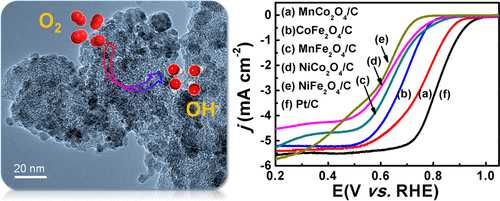当前位置:
X-MOL 学术
›
Energy Fuels
›
论文详情
Our official English website, www.x-mol.net, welcomes your feedback! (Note: you will need to create a separate account there.)
Versatile Synthesis of Ultrafine Ternary Spinel Oxides/Carbon Nanohybrids toward the Oxygen Reduction Reaction
Energy & Fuels ( IF 5.3 ) Pub Date : 2020-07-03 , DOI: 10.1021/acs.energyfuels.0c01901 Shulin Zhao 1, 2 , Tao Guo 1 , Jiayao Fan 2 , Lei Wang 2 , Min Han 2 , Jing Wang 1 , Yuping Wu 1 , Yuhui Chen 1
Energy & Fuels ( IF 5.3 ) Pub Date : 2020-07-03 , DOI: 10.1021/acs.energyfuels.0c01901 Shulin Zhao 1, 2 , Tao Guo 1 , Jiayao Fan 2 , Lei Wang 2 , Min Han 2 , Jing Wang 1 , Yuping Wu 1 , Yuhui Chen 1
Affiliation

|
Designing cheap and highly efficient electrocatalysts for the oxygen reduction reaction (ORR) is vital to advance fuel cells or metal–air battery technologies. Although great progress have been obtained, facile and versatile synthesis of ternary spinel oxides (AB2O4) and carbon nanohybrids (NHs) remains a challenging work and their applications in ORR have not been systematically investigated. In this work, a series of ultrafine AB2O4 nanocrystals/Vulcan C NHs, including MnCo2O4/C NHs, CoFe2O4/C NHs, MnFe2O4/C NHs, NiCo2O4/C NHs, and NiFe2O4/C NHs, are synthesized by directly refluxing bimetallic precursors and carboxylic-functionalized Vulcan C in an environmentally friendly solvent, i.e., 1,3-dimethyl-3,4,5,6-tetrahydro-2(1H)-pyrimidinone. This strategy does not need a high temperature, long reaction time, and post-annealing treatment, which is a simple, green, and easy method for scalable synthesis. In those NHs, all of the AB2O4 nanocrystals are ultrafine (∼5 nm) and dispersed uniformly on the C support. Among them, MnCo2O4/C NHs exhibit the highest catalytic activity, with an onset reduction potential of 0.96 V [versus reversible hydrogen electrode (RHE)] and a half-wave potential of 0.754 V (versus RHE). Related electrocatalytic dynamic tests reveal that the ORR mechanism follows the direct “4e–” process, and only 11.1% HO2– yield is generated at 0.5 V (versus RHE). As revealed from the microstructural and electrochemical measurement, the superior catalytic performance of MnCo2O4/C NHs can be attributed to their high specific surface area and low interfacial electron transfer resistance in relation to other AB2O4/C NHs.
中文翻译:

多功能三元尖晶石氧化物/碳纳米杂化物在氧还原反应中的多功能合成
设计用于氧还原反应(ORR)的廉价,高效的电催化剂对于推进燃料电池或金属空气电池技术至关重要。尽管已经取得了很大的进展,但三元尖晶石氧化物(AB 2 O 4)和碳纳米杂化物(NHs)的简便,通用合成仍然是一项艰巨的工作,尚未对其在ORR中的应用进行系统的研究。在这项工作中,一系列超细AB 2 O 4纳米晶体/ Vulcan C NHs,包括MnCo 2 O 4 / C NHs,CoFe 2 O 4 / C NHs,MnFe 2 O 4 / C NHs,NiCo 2 O 4/ C NHs和NiFe 2 O 4 / C NHs是通过在环境友好的溶剂(即1,3-二甲基-3,4,5,6-四氢-羟基苯甲酸酯)中直接回流双金属前体和羧基官能化的Vulcan C来合成的2(1 H)-嘧啶酮。该策略不需要高温,较长的反应时间和后退火处理,这是一种简单,绿色且易于扩展的合成方法。在这些NHs中,所有的AB 2 O 4纳米晶体都是超细的(〜5 nm),并且均匀地分散在C载体上。其中,MnCo 2 O 4/ C NHs表现出最高的催化活性,起始还原电位为0.96 V [可逆氢电极(RHE)],半波电位为0.754 V(相对RHE)。相关的电催化动力学测试表明,ORR机制遵循直接的“ 4e – ”过程,在0.5 V(相对于RHE)下仅产生11.1%的HO 2 –产率。从微观结构和电化学测量可以看出,MnCo 2 O 4 / C NHs的优异催化性能可归因于相对于其他AB 2 O 4 / C NHs的高比表面积和较低的界面电子传递阻力。
更新日期:2020-07-16
中文翻译:

多功能三元尖晶石氧化物/碳纳米杂化物在氧还原反应中的多功能合成
设计用于氧还原反应(ORR)的廉价,高效的电催化剂对于推进燃料电池或金属空气电池技术至关重要。尽管已经取得了很大的进展,但三元尖晶石氧化物(AB 2 O 4)和碳纳米杂化物(NHs)的简便,通用合成仍然是一项艰巨的工作,尚未对其在ORR中的应用进行系统的研究。在这项工作中,一系列超细AB 2 O 4纳米晶体/ Vulcan C NHs,包括MnCo 2 O 4 / C NHs,CoFe 2 O 4 / C NHs,MnFe 2 O 4 / C NHs,NiCo 2 O 4/ C NHs和NiFe 2 O 4 / C NHs是通过在环境友好的溶剂(即1,3-二甲基-3,4,5,6-四氢-羟基苯甲酸酯)中直接回流双金属前体和羧基官能化的Vulcan C来合成的2(1 H)-嘧啶酮。该策略不需要高温,较长的反应时间和后退火处理,这是一种简单,绿色且易于扩展的合成方法。在这些NHs中,所有的AB 2 O 4纳米晶体都是超细的(〜5 nm),并且均匀地分散在C载体上。其中,MnCo 2 O 4/ C NHs表现出最高的催化活性,起始还原电位为0.96 V [可逆氢电极(RHE)],半波电位为0.754 V(相对RHE)。相关的电催化动力学测试表明,ORR机制遵循直接的“ 4e – ”过程,在0.5 V(相对于RHE)下仅产生11.1%的HO 2 –产率。从微观结构和电化学测量可以看出,MnCo 2 O 4 / C NHs的优异催化性能可归因于相对于其他AB 2 O 4 / C NHs的高比表面积和较低的界面电子传递阻力。


























 京公网安备 11010802027423号
京公网安备 11010802027423号